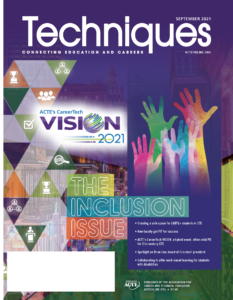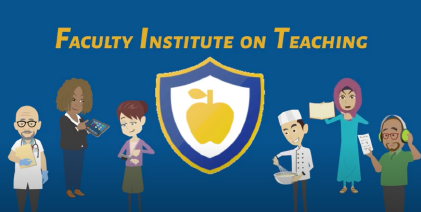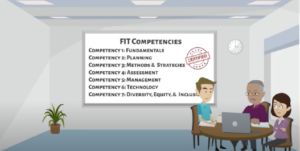Getting new faculty FIT for success
 Industry experts spend years or even decades perfecting their trade. However, they may have little or no experience as a faculty member. Without support in the transition from business and industry to academia, new faculty may lack the foundation and skills needed to be effective in the classroom.
Industry experts spend years or even decades perfecting their trade. However, they may have little or no experience as a faculty member. Without support in the transition from business and industry to academia, new faculty may lack the foundation and skills needed to be effective in the classroom.
Providing comprehensive, individualized training and guidance to new faculty increases preparedness.
High-quality professional development ensures new faculty acquire vital knowledge. Application of strategies leads to engaged, successful students who are ready for the workforce.
Kentucky Community and Technical College System (KCTCS) is comprised of 16 colleges with more than 70 campuses serving approximately 100,000 credit and 45,000 workforce students annually. Our colleges hire many career and technical education (CTE) faculty/instructors directly from industry. As they play an integral part in preparing our future workforce, KCTCS colleges strive to hire, support, and retain top faculty and instructors.
After the 2019 Perkins needs assessment, multiple schools identified the need for a high-quality new faculty professional development program, especial.ly for industry experts transitioning into CTE teaching roles. Recognizing the systemwide opportunity, the Office for Professional Development and Innovation (OPDI) developed a robust framework to build a foundational teaching and learning program.

Faculty Institute on Teaching, or FIT
The KCTCS Faculty Institute on Teaching (FIT) provides a structured professional development program that prepares and supports CTE faculty and instructors with teaching and learning strategies for our college students. As executive director of OPDI, I developed and presented the program concept to a statewide team of 27 experienced faculty and staff from KCTCS colleges. They confirmed the need and supported the idea enthusiastically. What’s more, they agreed to help design the program for implementation in fall 2020 based on the framework presented.
During June 2020, the development team met virtually and created a delivery model that focused on the foundations needed for teaching. The program combines existing tools and resources with evidence-based methodologies and individualized guidance, practice, and support for new CTE faculty.
FIT is a multipronged, yearlong, competency-based program designed to provide the foundational principles, skills, structure, and mechanics needed for a successful and effective course, whether it be in-person, hybrid or online. The Institute consists of four main parts:
- Knowledge and understanding through consistent curriculum
- Application and implementation assessment
- A digital badge reward system
- A mentor program to provide support
Utilizing backward design strategies, the development team established competencies new faculty need to be relevant and effective for student success. These were broken down into five topics, or modules:
- Fundamentals
- Planning
- Methods and Strategies
- Assessment
- Management
Embedded in each of the topics were two additional topics:
- Technology
- Diversity, Equity and Inclusion

Curriculum
With competencies set, we needed to find reliable, vetted content to support the curriculum. Due to limited resources, we could not develop and continually maintain the content ourselves. We needed a sustain.able, long-term solution that met the goals of FIT. We wanted a solution that would also allow us to expand the program to additional tracks in the future. What we found exceeded our expectations.
We discovered CTE Learn, created by ACTE and MaxKnowledge. CTE Learn offers a “comprehensive professional development solution.” Further investigation revealed that this learning management system housed more than 150 courses (now having grown to 170+) built by faculty for faculty. Additionally, the content is vetted, updated and available at a reasonable yearly rate for users.
We found that this collection met (and surpassed) our needs and decided to adopt CTE Learn as the curriculum. The team selected six courses to meet established competencies of the five FIT modules. As an additional advantage, participants have access to the entire repository for the year. This provides additional opportunities to customize their learning and experience.
Application & assessment
FIT design requires ensuring new faculty can effectively apply the concepts and skills being learned with proficiency. Modeling good instructional design standards, developers created competency-based assessments and provided rubrics, sample work, and templates to support successful application of strategies.
Three experienced KCTCS faculty assess participants against a detailed rubric. Assessors work collaboratively to provide feedback to help participants reach the proficiency level on all module competencies. This allows a safe space to ensure understanding and verify appropriate usage in the classroom. Participants receive feedback and support and revise as necessary until they achieve proficiency.
Once participants successfully finish a CTE Learn course, they then implement their learning into their own courses. And this completes the module. Each FIT modules consists of the CTE Learn course plus the assessment and implementation of learned skills.
Digital badges
Digital badges identify success throughout the Institute. In general, digital badges recognize an achievement or skill through review and verification. FIT, however, wanted to do more than award individual module badges. We also wanted participants to be able to track their progress through the program, at any given point. At the end of their term in FIT, an overall badge would be awarded representing completion of the program.
We chose the digital badging platform Badgr, which gave us this option with its pathways feature. Our goal was to use this feature to design the pathway with all modules and checkpoints in the program. Upon successful completion of each step, the badge on the path would light up. Badgr Pro’s pathways feature can be designed with externally verified badg.es, allowing users to earn badges from other verified badge issuers. This offered big benefits for KCTCS because it eliminates duplication of effort while saving time and money.
We circled back to MaxKnowledge to see if the CTE Learn courses offered badges. If they did, we could utilize their badges on our pathway, thereby saving our own resources. Although CTE Learn did not currently offer badges, they were simply waiting for a push from the education field.
MaxKnowledge got to work adding digital badging to all courses in the repository! They expedited their efforts and completed their badges in time for our pilot cohort in September 2020.
Mentorship
Next, we focused on the fourth part of FIT. Each participant was assigned a mentor from their KCTCS college. The mentor provided guidance and support throughout the program. Mentors also answered questions and helped acclimate new faculty to the other faculty, the faculty culture and the campus culture.
We launched the Faculty Institute on Teaching in fall 2020.
One participant stated, “Being able to take my industry insight and experience and lay it out in an orderly fashion for the students has been super awesome. Instead of just trying to dump every.thing I know onto them, I’ve been learning how to strategize and categorize my content.”
We asked participants about improving the program, and we received great ideas to consider. Many of them were about time. Participants discussed not having enough time to complete the program. This was understandable, especially during COVID-19. But they still wanted to complete the program! They even asked us to extend it to allow them more time. This kind of feedback let us know we were on the right track.
By the end of May 2021, a handful of participants had completed the entire program. Several more are working to.ward that goal. In total, more than 200 badges have been awarded to FIT participants so far. The pilot cohort continues to work through modules; they have until December to complete the program.
Looking ahead
During June 2021, a team collaborated to improve FIT based on feedback provided by the pilot cohort. After reviewing and analyzing the course for continuity, we identified several improvements.
We streamlined the program to remove redundancy and promote consistency. All competencies, badges and the frame.work were kept intact. However, the fifth module, Classroom Management, was incorporated as an underlying competency (along with Technology and Diversity, Equity and Inclusion) of the remaining four modules. To alleviate time concerns, we established a suggested timeline of completion, allowing two months to complete each module.
KCTCS considers FIT a success. The nominal cost for a year of learning, growth and support — not to mention the networking — is well worth continuing the program for new faculty.
Paige Brooks-Jeffiers is the executive director of professional development and innovation at KCTCS. She has more than 19 years of experience working with faculty and staff in higher education. Her career began in distance learning where she trained and supported faculty transitioning to an online format, including teaching strategies and technology. Currently, she runs the Office for Professional Development and Innovation and develops, implements, and facilitates innovative PD events to increase student success through faculty and staff support and engagement.
